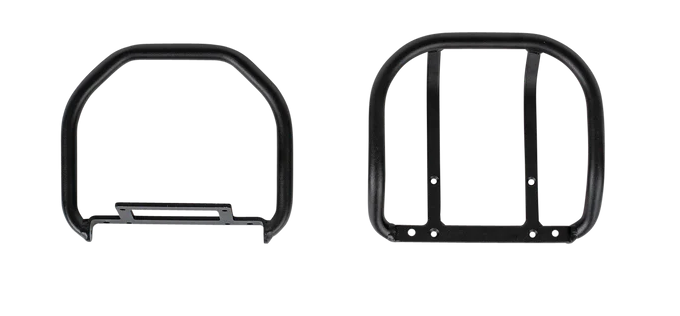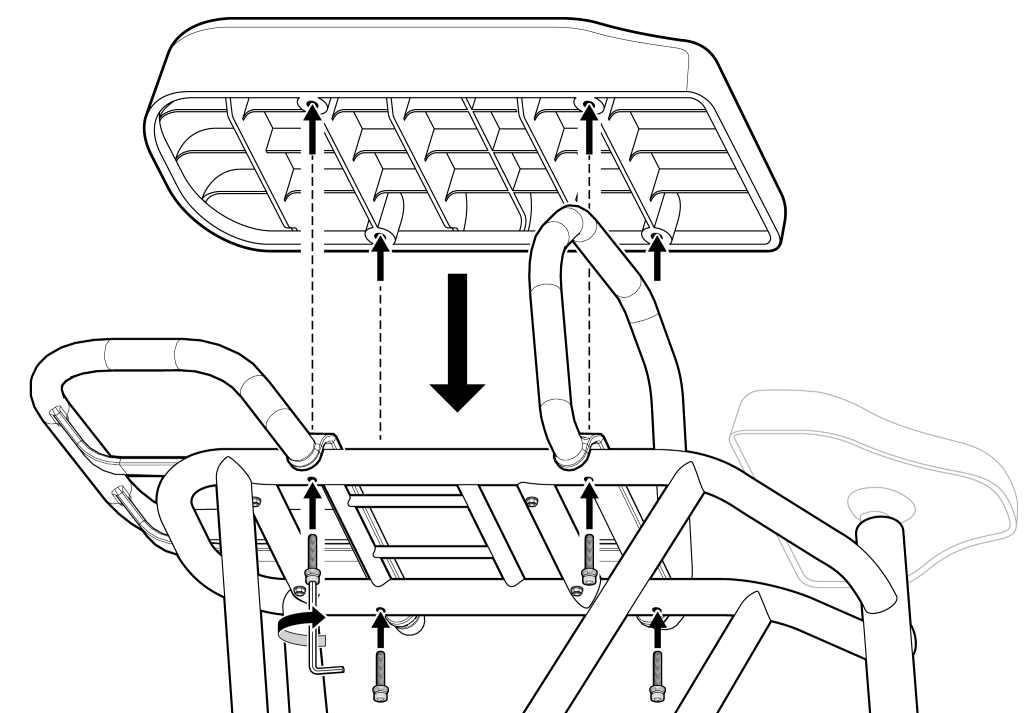RadRunner Passenger Bars installation
The RadRunner Passenger Bars must be used with all of the components of the RadRunner Passenger Package, which includes a passenger seat, wheel skirt, and folding passenger foot pegs. The Passenger Package is sold separately for some RadRunner models, and can be purchased at radpowerbikes.com.
The RadRunner Passenger Bars provide something for passengers to hold onto to help them balance and stay seated on the passenger seat. The installation instructions below assume you already have a Passenger Package (passenger seat, wheel skirt, and passenger foot pegs) installed on your RadRunner.

To use this product as safely as possible, you MUST read and understand all of the information in your RadRunner Owner's Manual, available HERE, paying special attention to any information on carrying passengers and riding with extra weight (passengers, cargo).
TOOLS YOU WILL NEED
To install your passenger bars, you'll need the following tools:
- 5 and 6 mm Allen wrenches
- Torque wrench with 5 and 6 mm Allen bits
- 5 mm wrench
Hardware may vary (bolt head style) and/or require different tools. Use the appropriate head size and type of tool for your bolts. Ensure the tool is pressed firmly into the bolt head and turn slowly to prevent stripping.
BEFORE INSTALLING
Before you install your Passenger Bars, you need to decide which hardware kit to use for installation. Your RadRunner Passenger Bars may come with two hardware kits:
- One will be labeled hardware kit #1, and is for use with any RadRunner model that features unthreaded mounting points on its rear rack. Such models include the RadRunner 1, the RadRunner 1 Plus, and the RadRunner 2 (available in some countries). These mounting points (holes) go all the way through your rear rack tubing. If you have a passenger seat that is attached to your rear rack using bolts that come up through the underside of your rear rack, you have unthreaded mounts.
- You may have a second kit, labeled hardware kit #2, which is for use with RadRunner models that have threaded mounts on the rear rack. These mounting points do not go all the way through the rack tubing.
INSTALLATION: UNTHREADED MOUNTING POINTS (KIT #1)

Figure 1: Removing the passenger seat (RadRunner with unthreaded mounts)
These steps apply to the RadRunner 1, RadRunner 1 Plus, and the RadRunner 2. To install your Passenger Bars, follow these steps:
- Remove the passenger seat from your rear rack by loosening its mounting bolts, nuts, and washers on the underside of the rear rack (see Figure 1).
- Install the RadRunner Passenger Bars. Position the bars as shown in Figure 2. Pass one of the M5 flat-head bolts (the shorter bolts from kit #1) through each mounting point. On the underside of the rack, place a washer and locknut from your kit on the end of the bolt. Tighten by hand. Repeat with the other three bolts, and torque each bolt to 4 Nm.

Figure 2: Installing the Passenger Bars (RadRunner with unthreaded mounts) - Reinstall the passenger seat. The Passenger Bars add a bit of space between the seat and the rear rack, so use the longer bolts from kit #1 to secure the seat, not the bolts you removed in step 1. Starting on the underside of your rear rack, insert each bolt through the mounting points and into the passenger seat as shown in Figure 3. Tighten by hand, and then torque each bolt to 6 Nm.

Figure 3: Reinstalling the passenger seat with the passenger bars (RadRunner with unthreaded mounts)
INSTALLATION: THREADED MOUNTING POINTS (KIT #2)
To install the passenger bars on RadRunners with threaded rear-rack mounting points:
- Remove your passenger seat using the method outlined in its documentation.
- Install the Passenger Bars using the hardware in kit #2, securing all eight bolts as shown in Figure 4.
- Re-install your passenger seat using the method outlined in its documentation.

Figure 4: Installing the RadRunner Passenger Bars (RadRunner with threaded mounting points)
CRITICAL SAFETY MESSAGES
Failure to use the Passenger Bars in conjunction with an installed passenger package, including a passenger seat, wheel skirt, and passenger foot pegs, can cause a passenger to fall off of the bike or to get body parts or clothing/gear caught in the rear wheel or other moving parts, leading to serious injury or death. Always use the Passenger Bars with the passenger seat, wheel skirt, and passenger foot pegs included with the Passenger Package, sold separately for some RadRunner models.
Pinch Hazard. When installing the passenger bars make sure there is adequate clearance between the passenger bars and any other component, such as a seat, so the passenger can safely hold on to the bars. Make sure to account for suspension seatposts or seats with springs that can compress downward and pinch the passenger’s hands and fingers.
Not all potential passengers have the physical size or ability to safely ride on the passenger seat, with or without passenger bars.
Riding with the increased weight of a passenger or heavy cargo can change handling characteristics of any bike. Please consult your RadRunner Owner's manual for all passenger- and cargo-related safety information.
If a passenger sits sideways, sits backward, stands, or kneels on the rear rack, passenger seat, or passenger pegs, or if their legs are not long enough for both of their feet to rest on the passenger pegs, the passenger is at risk of falling off the bike or causing the bike to crash, leading to serious injury or death. Always ensure that a passenger sits properly on the passenger seat, with legs on either side of the bike, feet resting on the passenger foot pegs, and hands holding onto the rider of the bike (not just their clothing) or the Passenger Bars accessory.
Exceeding the maximum payload (weight-bearing limit) of your bike, its rear rack, or other components can cause bike damage or lead to serious injury or death. Consult your owner's manual and any component-specific documentation for information on payload capacities.
